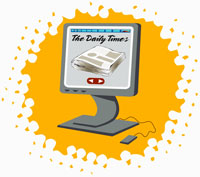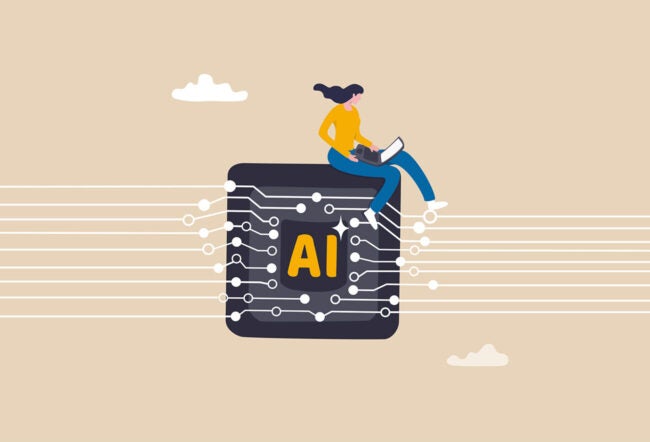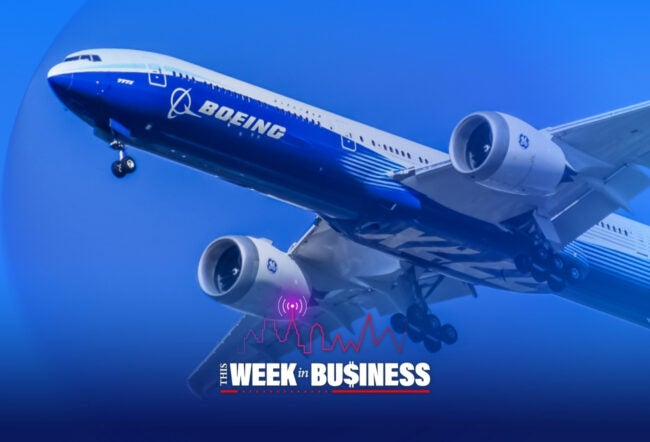After conquering the advertising frontier in cyberspace, Google, Yahoo and eBay are now turning to traditional media for future growth by brokering ad sales for offline media like radio, television and print. The Internet players’ foray into offline advertising could drive down rates, but advertisers and media companies may not completely abandon the current system of relationship-based sales for Internet auctions, according to Wharton faculty and industry executives. There will be little, if any, change in the way viewers see traditional media advertising. What will change are the middlemen who broker these ads.
Consumer-oriented ads are currently placed through a network of companies that are paid to bring advertisers and offline media companies together. The Internet companies hope to step into that space using automated auction technology to bring buyers and sellers of traditional advertising together the same way they now sell Internet ads for themselves and others.
Google plans to sell radio advertisements on stations through an online auction system it already uses to sell Internet ads. Google is also testing ad sales for a group of more than 50 newspapers, including the Washington Post and New York Times, that would use the company’s online auction system to sell space. Meanwhile, eBay is working on a system to place an estimated $50 billion in spots for large advertisers, including Wal-Mart, Microsoft and Home Depot, on cable television. Finally, Yahoo has an agreement with 176 newspapers to carry the papers’ local classified ads on its site, thereby giving newspaper advertisers wider distribution.
Driving Down Costs
Wharton marketing professor David Reibstein says the move into old-style media is a logical extension for the Internet giants, which are, at their core, distributors of advertising messages. “It would make sense that they would want to have a more complete portfolio available to advertisers. Their model is that they are going to deal with advertisers and help them reach audiences. The fact is, they can help not just in new-age advertising, but also in traditional advertising,” says Reibstein.
Traditional media advertising in the United States is a $150 billion market compared to $16 billion for online advertising, although the online market is growing at a rate of 30% a year. “The somewhat untold story of the upturn in the tech world is just how much has been driven by advertising,” says Kevin Werbach, professor of legal studies and business ethics at Wharton. “There has been a steady trend over the last 10 years of advertising dollars migrating online. We’re still relatively early in that process, and therefore it’s not surprising to see companies like Google trying to ply their expertise in targeting and brokering advertisements to venues outside of their online platforms.”
While new media companies seek out avenues for growth, advertisers are hoping the introduction of Internet technology into the process of media-buying will drive down costs, says Wharton marketing professor Leonard Lodish. “What advertisers want to have happen is the commoditization of media time so that it becomes a more transparent market [that is] sold to the highest bidder.”
According to Wharton marketing professor Peter Fader, online companies’ invasion of traditional media buying is only the latest example of the Internet’s ability to transform industry after industry. “A lot of people viewed advertising as a sacred area where only advertising people have expertise. I say ‘Phooey.’ There’s no reason any smart, resourceful firm should not be able to get in on the game — particularly those with a proven track record in a related area,” he says, adding that Google and the other Internet firms are looking at traditional media sales as an inefficient market where they can quickly harvest “big, tasty, low-hanging fruit.”
The Internet firms’ simultaneous rush into traditional media is another boon for advertisers because the companies will be competing against one another, preventing any one from gaining monopoly pricing power. In the end, says Fader, the broader economy, not just advertisers, will benefit, although the companies that currently broker advertising may be squeezed. “The biggest problem Google is going to face is both inertia from the entrenched players and natural fear and skepticism on the part of [advertisers]. But from the standpoint of technology and pleasing the customer, there is no reason Google can’t revolutionize this industry.”
Newspapers and other traditional media outlets may be bitter rivals with online companies when it comes to the content side of their operations, but when it comes to advertising revenue, they are willing to test new relationships with online partners, says Werbach. “To the extent a Google can deliver advertisers more efficiently to a newspaper than the other options, it would be cutting off their nose to spite their face to reject Google just because it is an online company.”
According to Wharton marketing professor David Schmittlein, Google and the other online companies may have a marginal impact on offline advertising, mostly by helping smaller, do-it-yourself advertisers find spots. He says most large advertisers already use the two largest media buying firms — Simmons Market Research Bureau and Mediamark Research — which are so dominant that they already provide customers with hefty discounts.
The scale of these companies also allows them to amass rich market research in the offline world that Google and the other online companies cannot match, says Schmittlein. “I understand traditional advertising and media companies are concerned about the inroads Google and the others are making, but I would be much more concerned, at least in the intermediate term, if I saw Google or Yahoo interested in buying one of the two big offline firms.”
Lodish says advertisers hoping for lower rates through Internet-based systems will need to watch out for conflicts of interest as the new media companies sell space that may compete with their own advertising vehicles, such as their company web sites. Initially, he sees little cause for concern because the Internet is markedly different than print, radio and television. Ultimately, the Internet firms will be tempted to bundle packages in order to get advertisers to pay for less popular spots — possibly on their own sites — the way television stations often require advertisers to take time on less popular shows if they want a prime spot on a hit series. “If Google starts to bundle them all together and aggregate them, then I think [there will be] conflicts of interest it will need to watch,” says Lodish.
A further challenge for Google and the other new media companies as they enter traditional advertising space is how to measure the impact of ad placement. Despite click-fraud, Lodish says Internet companies are used to operating with more information and may not have the experience or staff to give advertisers what they need in traditional media. “When you are buying radio, TV or newspaper advertising, it’s much less data-driven than the Internet. It’s all about what the audience is like and what its mood is at the time. A lot of that information comes from salespeople who are able to describe it well.”
Lodish says in-house sales staffs at traditional media companies and firms specializing in media sales are now pivotal players in the advertising world. “I think people may be overestimating Google and underestimating how important ‘people relations’ are in this business. A lot of media buyers for ad agencies have been dealing with [media sales specialists] for years, trust them and get a lot of good advice from them. I don’t think it’s going to be simple to go around that.”
Reibstein agrees that traditional media brokers will fight to hold their ground. “I can’t imagine they will just go away. They will continue to try and operate and will be strong competitors. It’s not as if all media are going to be automatically dominated by Google, Yahoo et al.”
The Industry View
Jay Zitz, CEO of Newspapers First, a consortium that sells advertising space for dozens of major regional newspaper companies, says large advertisers are not likely to turn to Google to help them place ads because they already have plenty of clout with individual papers. “Federated Department Stores, General Motors or other major advertisers that use newspapers as a big part of their media mix already have strong relationships and high expectations about where their advertisements will run,” notes Zitz.
Newspapers still retain the right to refuse advertising if they don’t think the price is right, and advertisers will not be willing to risk losing space in an important newspaper market in favor of a low-cost Internet auction, he adds.
Zitz says he is not concerned that the newspapers cooperating with Internet advertisers are opening themselves up to eventual domination by their new media rivals. “If that were a serious concern, you would not see companies like The Washington Post and The New York Times doing it,” he contends.
Lou Rubin, managing director of DPrime Consulting, a unit of Omnicom Group, says the Internet auction approach may work for some types of mass, high-volume advertising, but not for a more targeted approach. “If you are trying to reach an upscale C-suite executive who has influence over public equity markets, then that’s where judgment and experience are difficult to replace. If all you are interested in is tonnage, then an automated or Internet-based way to buy and place media is great. It makes it efficient,” he says
Rubin stresses that advertising is more than putting messages in front of potential buyers. He says customer engagement is the most important goal and may require a wide range of vehicles — including conferences, event marketing and word-of-mouth marketing. “Will Google and Yahoo create more engagement? No. They will create better efficiencies and that’s fine, but I’m not sure efficiency is the root of the issue,” he says. “The root of the issue is customer engagement.”
Ralph Guild, CEO of Interep, an independent national sales and marketing firm specializing in radio, the Internet and new media, points out that the evolving advertising world does not prevent traditional media players from getting involved in the Internet space. “Everything is a two-way street,” he says. “Google may be getting into traditional media, but traditional media can also go the other way. You have CBS or Clear Channel with the financial power to compete in that direction if it looks like it’s a viable option.”
In addition, he says, the media-buying landscape could be altered again by an upstart company with a breakthrough technology or a revolutionary business model. Major radio corporations or a start-up could consolidate independent radio stations in a system that could compete with Google, says Guild, although he acknowledges that Google seems to have an unlimited ability to attract new capital to underwrite new ventures.
Guild also argues that there is probably room in the market for Internet firms and traditional media placement operations to co-exist. His own company, he notes, experienced strong growth in the early 1960s as other radio representation firms defected to television sales.
Radio revenues have increased nearly every year since the 1930s, and Guild says he is not concerned that Google will drive down rates substantially or undermine the success of the medium. “Most people think that when something new comes along, it comes at the total expense of the traditional media, or that the traditional media is going to win out. The fact is they both survive and find ways of working together.”
According to Fader, the models Google and others are using currently replace work that is already being done. But that may change. “Who knows where it might go from there?” he asks. “They are starting with the conventional players and mechanisms, but it’s entirely conceivable that five years from now the way advertising is bought, created and consumed will be completely different.”
Rubin says advertising agencies are undergoing a revolution and that creative services could be another target for Google and other Internet companies. “The combination of content, branding and individualism, and the intersection between people and the LCD screen, is ever-unfolding.” Google, Yahoo and other Internet firms might be thought of as transformative distributors of content, the way railroads and highways changed distribution patterns, Rubin adds. But if they remain simple distribution networks, without control of the content they bring, they may die away as new systems rise up.
“How will they define their business going forward? If it’s as an information system and a disintermediator — that’s finite,” says Rubin. “If it is as a content developer and provider, that lasts a lot longer — perhaps indefinitely. That’s the next phase for them.”
At the moment, Rubin says, it seems Google can do whatever it wants. “They have created a culture, an environment and a great market cap. I think anything is possible for Google,” he says. “I’m just waiting for them to set up their own country.”



